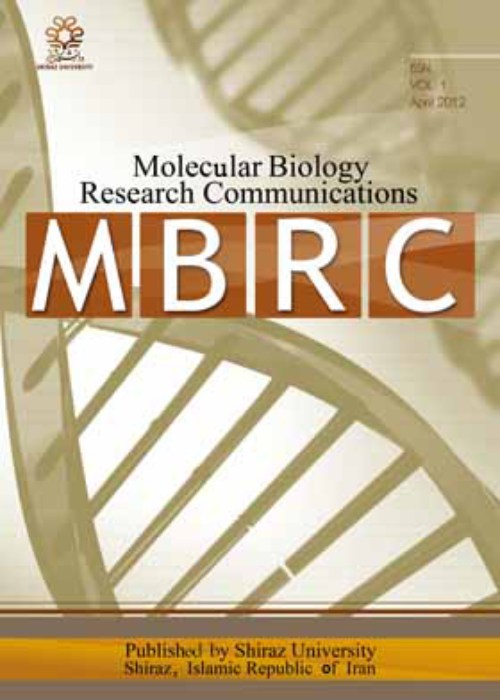فهرست مطالب

Molecular Biology Research Communications
Volume:12 Issue: 4, Dec 2023
- تاریخ انتشار: 1402/09/10
- تعداد عناوین: 4
-
-
Pages 133-137The present study aims to determine the association between a genetic polymorphism of GSTP1 (rs1695) and the risk of periodontitis. This study used a cross-sectional design and included subjects from the South Indian population. A total of 100 individuals enrolled at Saveetha Dental College and Hospital, Tamil Nadu were included in this study. The participants were divided into control (n=50) and periodontitis (n=50) based on clinical examination. Blood samples were collected. Genotyping was performed using specific primers spanning the polymorphic site. The genotypic frequencies for the rs1695 polymorphism were not significantly different between cases and controls.Keywords: Genotype, GSTP, Periodontitis, Polymorphism
-
Pages 139-148The most often diagnosed and fatal malignancy in women is breast cancer. The International Agency for Research on Cancer (IARC) estimates that there are 2.26 million new cases of cancer in 2020. Adoptive cell therapy using T cells with chimeric antigen receptor shows potential for the treatment of solid tumors, such as breast cancer. In this work the effectiveness of CAR-T cells against monolayer and three-dimensional bioprinted tumor-like structures made of modified MCF-7 breast cancer cells was assessed. The cytokine profile of supernatants after co-cultivation of MCF-7 tumor cell models with CAR-T cells was also measured to reveal the inflammatory background associated with this interaction.Keywords: Breast cancer, MCF-7, CAR-T, Immunotherapy, Solid tumor
-
Pages 149-154Human BK polyomavirus (BKPyV) is a latent infectious agent in the genitourinary tract associated with hemorrhagic cystitis and nephropathy. This virus can be a risk factor for various human malignancies, including prostate cancer (PCa). It may contribute to prostate cancer development, as it demonstrates oncogenic properties by encoding oncoproteins. This study assessed the prevalence of this virus in benign and malignant prostate tissues. Between 2009 and 2019, 49 formalin-fixed paraffin-embedded (FFPE) PCa and 49 benign prostatic hyperplasia (BPH) samples were gathered from the pathology department of a tertiary care university hospital. They were used as cases and controls, respectively. After deparaffinization and DNA extraction, nested PCR was applied to identify the BKPyVgp5 gene (LTAg) using inner and outer primers. The nested PCR showed a 278-bp bond corresponding to the BKPyVgp5 genome (LTAg) in 53.1% (26/49) of PCa and 14.3% (7/49) of BPH (p<0.001). The presence of BKV was significantly associated with an increased risk of PCa development (OR=6.78, 95% CI=2.55–18.02, p<0.001). The BKV LTAg gene was significantly more prevalent in PCa samples than in BPH samples. These results demonstrate the presence of the virus in prostate cancer tissues.Keywords: BK Virus, Prostate Cancer, Benign Prostatic Hyperplasia, nested PCR
-
Pages 155-163
Circumscribing species boundries is necessary in systematic plant biology. Even a mistake in delimiting taxa may lead to incorrect scientific interpretations. Draba rimarum (Rech.f.) A.R. Khosravi & A. Eslami-Farouji is an endemic Iranian species with a narrow geographic distribution, and is genetically close to D. aucheri. The present study provided a phylogenetic review, time divergence, and planar network of both species to unravel the distinct position of both species along with the prediction of any conflicting or ambiguous signals. Regarding this purpose, here we represent that phylogenetic trees may fail to show reliable results toward the distinct position of genetically close species.
Keywords: Cruciferae, Distance-based methods, Draba, Genetically close species


